
RIVER RESEARCH
River research at IWA encompasses a wide range of disciplines that focus on the functioning, dynamics, and interactions within river systems. To capture these complex processes, innovative measurement methods and inter- and transdisciplinary concepts are essential. The goal is to develop strategies and measures for sustainable and resilient hydraulic engineering based on this understanding.
At IWA, processes are studied directly in the field to collect natural measurement data. Innovative measurement methods are employed, providing new and high-quality insights into river processes on an international scale. IWA’s expertise includes comprehensive monitoring of sediment transport in rivers, analysis of micro- and macroplastic transport, investigation of interactions between rivers and vegetation, and research on coherent structures in flow mechanics. A particular focus is placed on involving diverse stakeholders and scientific disciplines to address research questions comprehensively. The research topics are as diverse as the characteristics and scales of the study areas, ranging from transport processes in steep mountain streams to large gravel-bed rivers like the Danube. Field data and process knowledge obtained in natural settings are further refined through complementary monitoring efforts in the laboratory.
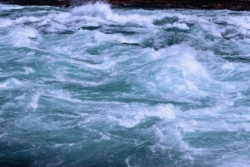
Water Transport
The flow of water plays a central role in river systems. Driven by gravity, water flows downstream within its channel. Water depth and flow velocities depend on factors such as the roughness of the riverbanks and bed, the channel slope, and the cross-sectional geometry. While straight channels with uniform cross-sections can often be approximated as one-dimensional, most rivers exhibit complex three-dimensional flow patterns. Except in shallow, low-flow zones or heavily impounded areas, river flow is typically turbulent. Turbulent flows exert shear and pressure forces on the river boundaries and are crucial for mixing processes, the distribution of dissolved substances and suspended particles, and the transport of bedload, plastic, and other materials within the river system.
Sediment Transport – Bedload and Suspended Load
The sediment balance and continuity of rivers are fundamental to their morphology and functionality. The dynamic equilibrium between sediment transport, redistribution, and deposition is often disrupted by interventions such as the construction of sediment traps, weirs, reservoirs, and river regulation for flood protection or navigation. These interventions have well-documented negative effects on both ecology and hydraulic engineering. Natural measurement data are therefore essential to understand the impacts of such interventions and to develop appropriate measures based on an enhanced understanding of processes.
The quantity and composition of transported sediment (bedload and suspended load) exhibit significant temporal and spatial variability, influenced not only by hydraulic conditions but also by sediment availability. Measuring sediment transport presents numerous challenges, requiring innovative approaches and methods. At IWA, extensive long-term monitoring is conducted in collaboration with hydrographic services and ministries (BML, BMK) at multiple stations, ranging from steep mountain streams to the Danube. The data collected enable the investigation of transport processes and their application in calibrating and advancing transport formulas and numerical models.
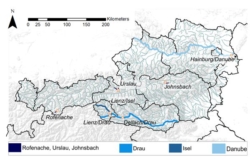
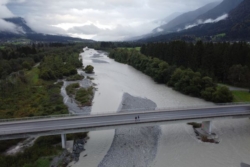
Development of Sediment Management Concepts
Sustainable and resilient approaches to river management require the development of comprehensive sediment management concepts. These concepts include strategies and methods for capturing, analyzing, and managing sediments to better understand and control the effects of erosion, sedimentation, and other geomorphological processes. In addition to natural measurement data on bedload and suspended load, geomorphological surveys within the catchment area play a central role. Using drones, cameras, and LiDAR sensors, high-resolution data on sediment volumes and morphological structures can be collected in the field. These data enable the creation of precise three-dimensional models, providing valuable insights into sedimentation behavior in retention areas, dynamic flow processes, and potential changes in river courses.
Transport of Micro- and Macroplastics
The widespread use of plastic, due to its versatility and durability, remains unbroken. In 2020, approximately 20 kg of plastic was produced per capita worldwide. Because of its longevity and the fact that only a small fraction is recycled or incinerated, most plastic remains in the environment. If not properly disposed of, it can eventually enter the food chain and be ingested by humans. Addressing this issue requires urgent research into transport pathways, key entry points, and effective methods for removing plastic from the environment.
IWAH has been researching plastic transport in rivers for several years, aiming to quantify and characterize it. The goal is to identify the main sources of plastic pollution and develop measures to reduce or prevent further input. Research on this topic has been conducted in various locations, including the Danube, the Austrian Alps, Vietnam, and one of Europe’s most polluted rivers, the Ishem River in Albania.
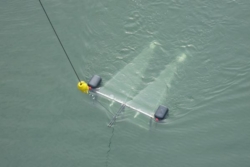
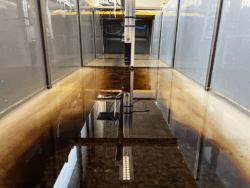
Transport of Nutrients and Pollutants
Rivers possess a remarkable self-purification capacity through physical, chemical, and biological processes. However, the interplay of microbial activity, plants, and aquatic organisms such as macroinvertebrates and fish is in a delicate balance that can be disrupted by external influences. Sources of such disturbances include the discharge of pollutants from industry, mining, and transportation, as well as pharmaceuticals and personal care products. The complex pathways of pollutant entry (point sources, dry and wet deposition) combined with climate change are leading to growing societal challenges, such as biodiversity loss, threats to drinking water supplies, and food security.
At IWAH, research focuses on the challenges of particle-bound pollutant transport in the context of river morphology, which acts as a boundary for maintaining and restoring self-purification processes. The aim is to gain a better understanding of particle-bound pollutant transport processes in rivers. This research contributes to the United Nations’ Sustainable Development Goals, particularly “Clean Water and Sanitation,” “Sustainable Cities and Communities,” and “Life Below Water.”
Interaction between Rivers and Vegetation
During high flows, vegetation on floodplains and, increasingly, on sediment bars within channels due to restoration projects interacts with flow and sediment transport. Vegetation increases the hydraulic roughness of inundated areas, influencing flow patterns, water levels, and the retention capacity of floodplains, making it particularly relevant for flood protection. At the same time, vegetation affects sediment transport and can influence morphological development, which is critical for many river functions.
Calculating the effects of flexible vegetation, which often occurs near riverbanks under specific habitat conditions and interacts with flow and transported sediments, presents a significant challenge. The large flow capacities of the hydraulic engineering laboratory allow for full-scale experiments on plant deformation and sediment transport. Combined with field and laboratory measurements, IWA develops computational models, such as finite element models for simulating plant deformation and dynamic roughness. These models are coupled with hydrodynamic-numerical and sediment transport models to improve predictions of morphological changes and flood impacts while accounting for vegetation.
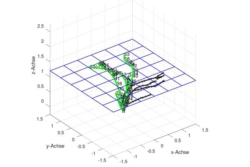

Socioeconomic Aspects
IWA adopts integrative approaches in its research, fostering close collaboration and exchange with various scientific disciplines and relevant stakeholders. Particular emphasis is placed on involving diverse stakeholder groups to incorporate different perspectives and expertise into the research process. This approach enables comprehensive analysis and solution development that considers scientific insights alongside practical, societal, and ecological requirements. Interdisciplinary dialogue and networking with external partners significantly enhance the quality and relevance of research outcomes.